### I. PRELUDE: THE EXPULSION OF PROFESSOR GURMUKH SINGH
On March 18, 1887, the Akal Takht issued a _hukamnama_ excommunicating Professor Gurmukh Singh from the Khalsa Panth. The order is reproduced below.
---
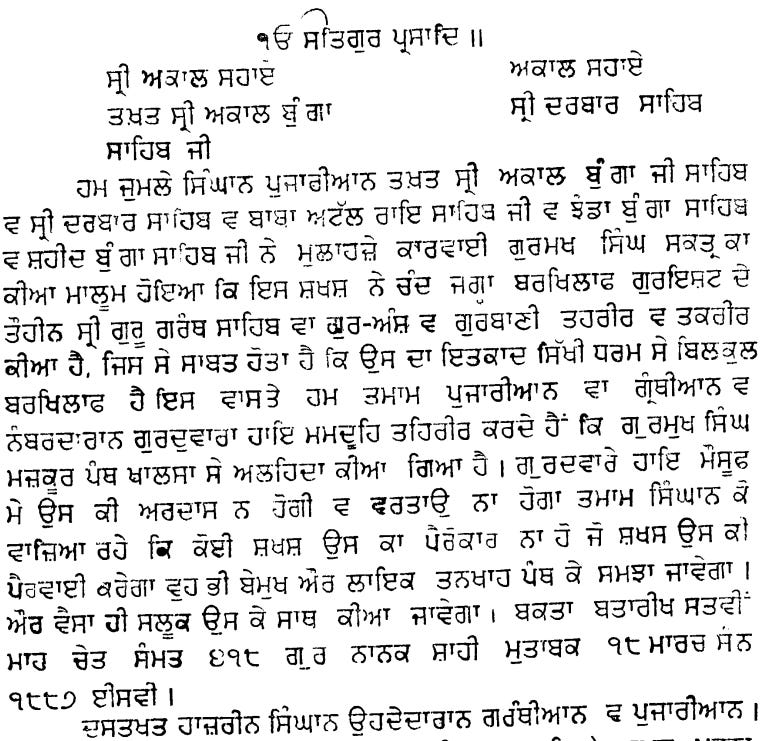
As found on p. 12, _Singh Sabha Lahir di Modhi: Professor Gurmukh Singh Ji_, Gurmat Missionary College (1977) (hereinafter “PGSJ”).
---
Gurmukh’s excommunication was the climax of more than a decade’s worth of ideological clashes within the Singh Sabha movement. The Sabha had begun in Amritsar in 1873 with the aim of preserving Sikh tradition. Gurmukh, at the young age of 24, was one of the founding members.[1](https://substack.com/home/post/p-150032752?utm_campaign=post&utm_medium=web#footnote-1-150032752) He had been studying at Government College, Lahore, when he left to dedicate his life to the Sikh community.[2](https://substack.com/home/post/p-150032752?utm_campaign=post&utm_medium=web#footnote-2-150032752) At the time, he held no formal position in the Sabha, but undertook its cause with zeal. He aided the 1877 effort to institute Punjabi classes in Oriental College, Lahore, classes for which he was immediately hired as a professor.[3](https://substack.com/home/post/p-150032752?utm_campaign=post&utm_medium=web#footnote-3-150032752) Apart from teaching, he traveled across Punjab in an effort to rekindle the spirit of Sikh youth shaken by the colonial project.[4](https://substack.com/home/post/p-150032752?utm_campaign=post&utm_medium=web#footnote-4-150032752) Around this time, Gurmukh was also granted permission from leaders in the Amritsar Singh Sabha to establish another base in Lahore, for which he was the founding Secretary.[5](https://substack.com/home/post/p-150032752?utm_campaign=post&utm_medium=web#footnote-5-150032752) He succeeded in recruiting then-Arya Samajists Jawahir Singh and Ditt Singh to the Lahore Singh Sabha[6](https://substack.com/home/post/p-150032752?utm_campaign=post&utm_medium=web#footnote-6-150032752) while it was still formally under its Amritsar counterpart. But their affiliation to Amritsar would soon change.
---
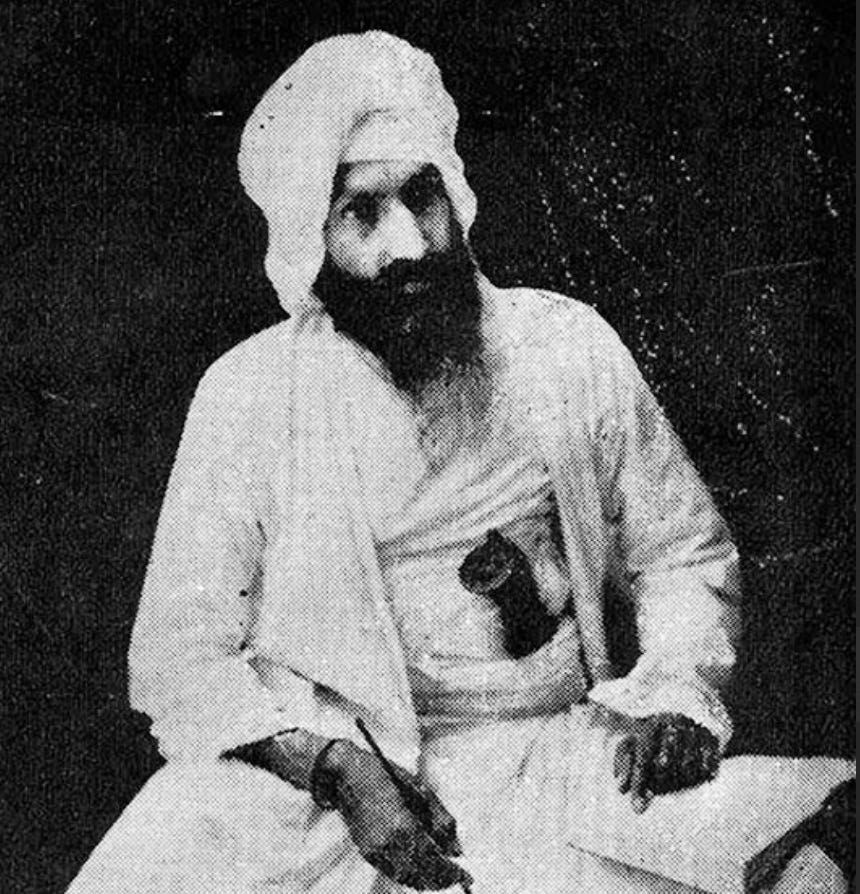
Professor Gurmukh Singh photographed in 1898
---
The available sources for why the rift between Lahore and Amritsar occurred have their ideological slant but are still worth considering. A biography of Gurmukh Singh claims that leaders of the Amritsar Sabha, who were largely drawn from the existing Sikh upper classes, looked down at Gurmukh for being “the offspring of a _langari_” because of his father’s occupation as a cook in the Kapurthala royal household.[7](https://substack.com/home/post/p-150032752?utm_campaign=post&utm_medium=web#footnote-7-150032752) On matters of religion, Gurmukh advocated a puritan interpretation of Sikhism in which the equality of every Sikh was promoted while idol worship and other Sanatan practices were banned.[8](https://substack.com/home/post/p-150032752?utm_campaign=post&utm_medium=web#footnote-8-150032752) Leaders of the Amritsar faction such as Sir Khem Singh Bedi disagreed. Khem Singh in particular maintained he and other descendants of the Gurus (“_anshis_”) were to be given the preferential treatment that precolonial Sikh societies such as Ranjit Singh’s court had given them. One practice in particular that divided the Amritsar and Lahore factions involved anshis sitting on a cushion in the presence of the Guru Granth Sahib.[9](https://substack.com/home/post/p-150032752?utm_campaign=post&utm_medium=web#footnote-9-150032752) Additionally, Gurmukh is said to have once had to remove an idol of Sahib Singh Bedi, an ancestor of Khem Singh, from being worshipped within the Darbar Sahib complex.[10](https://substack.com/home/post/p-150032752?utm_campaign=post&utm_medium=web#footnote-10-150032752) Things came to a head when, during a meeting of the Khalsa Diwan (a conference of all the Singh Sabhas) in October 1885, Gurmukh attempted to forcibly hoist Khem off of a cushion he sat on while in _darbar_.[11](https://substack.com/home/post/p-150032752?utm_campaign=post&utm_medium=web#footnote-11-150032752)
[
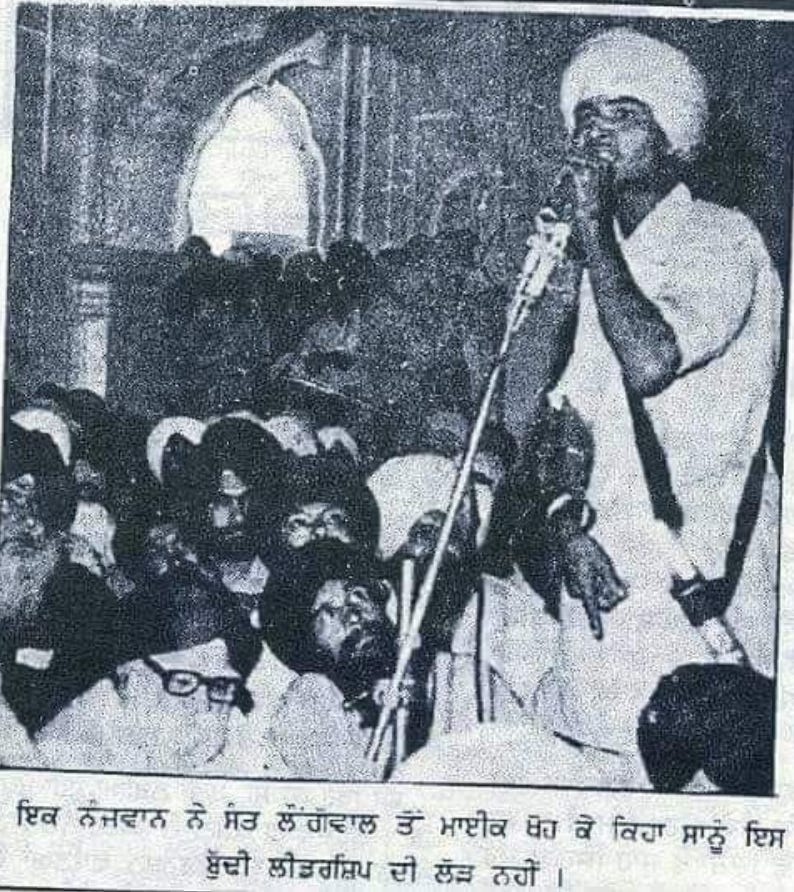
](https://substackcdn.com/image/fetch/f_auto,q_auto:good,fl_progressive:steep/https%3A%2F%2Fsubstack-post-media.s3.amazonaws.com%2Fpublic%2Fimages%2Fb75188b3-e808-420e-bb74-52bc8a7d239b_794x892.png)
“A young Sikh, grabbing the microphone from Sant Longowal, stated, ‘We have no need for this geriatric leadership!’”
That same month, Gurmukh issued a notice condemning _Khurshid-i-Khalsa_, a book advocating the return of exiled Maharaja Duleep Singh and glorifying the brutally-suppressed Kuka rebellion.[12](https://substack.com/home/post/p-150032752?utm_campaign=post&utm_medium=web#footnote-12-150032752) He ordered the author, the _thanedar_ (constable) Nihal Singh of the Kalsia state, to present himself and answer why he distorted reviews from prominent Sikh personalities to make it seem as if they supported the book’s anticolonial message.[13](https://substack.com/home/post/p-150032752?utm_campaign=post&utm_medium=web#footnote-13-150032752) But Khem Singh and other Sikh elites had lent their support toward _Khurshid-i-Khalsa_—and may have been involved in a shadowy plot to actually attempt to bring Duleep Singh back.[14](https://substack.com/home/post/p-150032752?utm_campaign=post&utm_medium=web#footnote-14-150032752) After Nihal Singh didn’t respond to his summons, in April of 1886 Gurmukh circulated a notice that the book is “unauthorized on behalf of 15 Sabhas, and the author is to be excluded from the Singh Sabhas.”[15](https://substack.com/home/post/p-150032752?utm_campaign=post&utm_medium=web#footnote-15-150032752) In retaliation to this almost-unilateral exclusion of Nihal Singh, the Amritsar leaders lobbied the Akal Takht authorities, then known as “pujaris,” to excommunicate Gurmukh Singh.
Who was right or wrong in the _Khurshid-i-Khalsa_ affair is not the subject of this piece. But it is interesting to consider who history considers the victor. Forty years later, the Lahoris—younger, educated, and adept at wielding the printed word, witnessed their doctrines manifest into reality during the Gurdwara Reform Movement. The campaign resulted in reformers taking over the Darbar Sahib complex in 1920 and appointing their own Jathedar, who would then issue a hukamnama to the Sikh world to gather at the Akal Takht for the appointment of a “Panthic Committee” to manage all gurdwaras.[16](https://substack.com/home/post/p-150032752?utm_campaign=post&utm_medium=web#footnote-16-150032752) The result of this was the abdication of much of the existing Sanatan-leaning authorities from gurdwara management in Punjab and the creation of the Shiromani Gurdwara Parbandhak Committee (“SGPC”).[17](https://substack.com/home/post/p-150032752?utm_campaign=post&utm_medium=web#footnote-17-150032752) In essence, the Amritsaris who had expelled Gurmukh Singh from the Panth all those years ago were now themselves shut out of Sikh affairs.
[
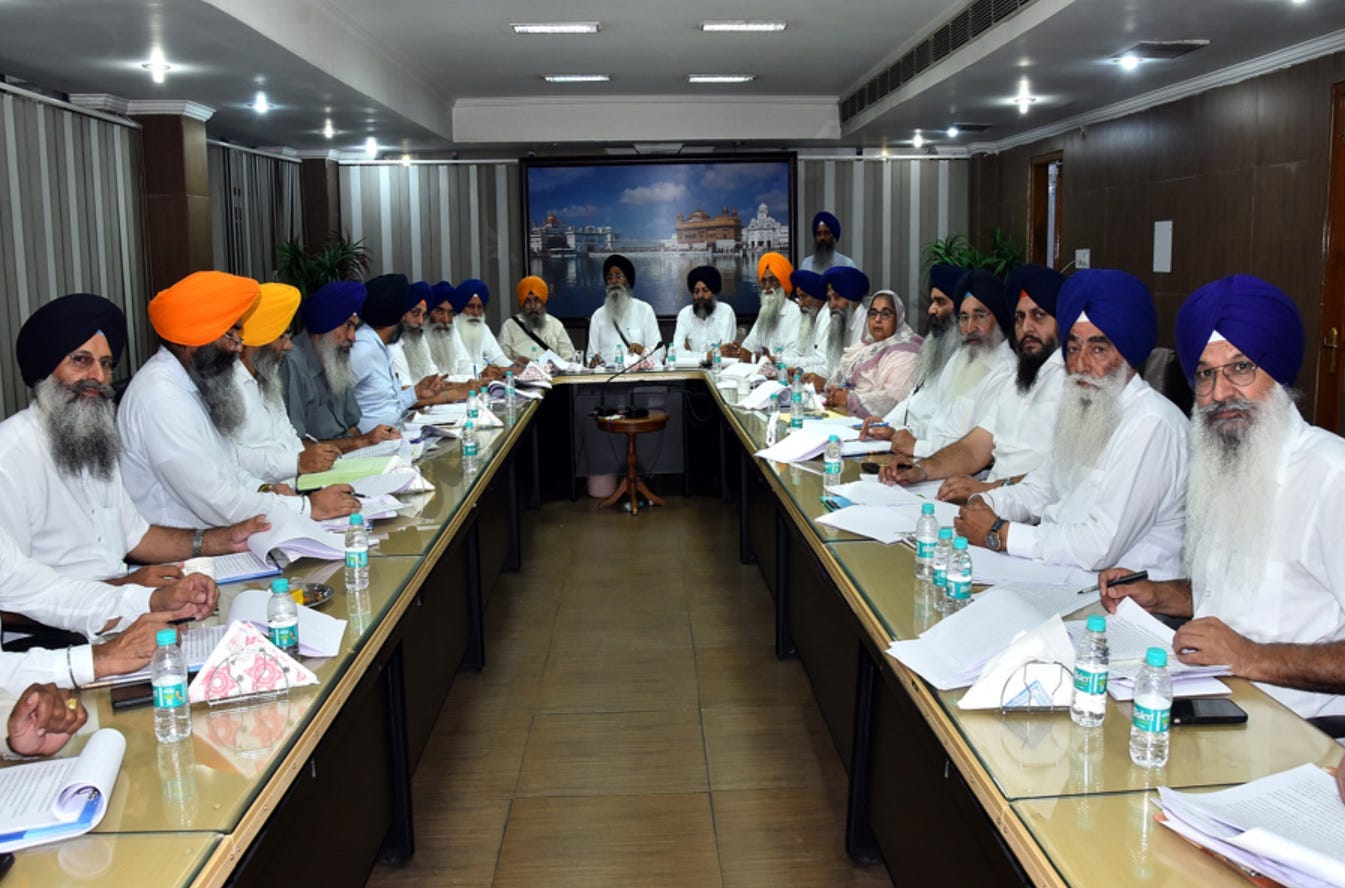
](https://substackcdn.com/image/fetch/f_auto,q_auto:good,fl_progressive:steep/https%3A%2F%2Fsubstack-post-media.s3.amazonaws.com%2Fpublic%2Fimages%2Fd606ad2c-859e-42a9-89e1-214fe8b9b995_1345x888.png)
A modern meeting of the SGPC chaired by President S. Harjinder Singh Dhami
As with the _Khurshid-i-Khalsa_ affair, the purpose of this piece is not to litigate the merits of either side of the Akali Movement. But there are some today who, in their uncritical obsession with “tradition,” contend that Gurmukh Singh and the Lahore reformers did not just incorrectly interpret Sikhism, but that Gurmukh Singh _did not possess the power at all to challenge tradition_. That the version of Sikhism received from the previous generation must be accepted point-blank, and _any_ change is automatically wrong because staying true to Sikh tradition means to practice it in its supposed “original” form.
The problem is, this view severely misreads Sikh tradition itself.
### II. SIKH YOUTH AND THE TRADITION OF ANTITRADITION
The role of the Sikh actor since Guru Nanak has been to challenge received tradition and authority. Even the most ardent “Sanatan Sikh” must admit Guru Nanak’s philosophy, even if simply a _return_ to ancient Vedic thought, involved a message of rebuke to _existing_ religious practices.
> ਪੜਿ ਪੁਸਤਕ ਸੰਧਿਆ ਬਾਦੰ
>
> Reading religious exegesis just for evening debates,
>
> ਸਿਲ ਪੂਜਸਿ ਬਗੁਲ ਸਮਾਧੰ
>
> Worshipping stones in “samadhi,” like storks…[18](https://substack.com/home/post/p-150032752?utm_campaign=post&utm_medium=web#footnote-18-150032752)
Such polemics are not only launched at other beliefs by the Gurus, but also to erroneous interpretations of Sikhism itself. Sikh tradition holds that the teenage Hargobind, while ascending to Guruship following the martyrdom of his father Guru Arjan, announced the militarization of the Sikh community in part by rejecting the _seli topi_ (silk hat) and _mala_ (rosary) that the _masands_ (then-cardinals of the Sikhs) claimed belonged to Guru Nanak. States Bhagat Singh romantically in _Gurbilas Patshahi Chevin_,[19](https://substack.com/home/post/p-150032752?utm_campaign=post&utm_medium=web#footnote-19-150032752)
> ਹਰਿਗੋਬਿੰਦ ਦਿਖ ਮਨ ਮੁਸਕਾਇ । ਬੁਡੇ ਜੀ ਕਉ ਬੈਨ ਅਲਾਏ ।
>
> Hargobind showed a playful smile, and said the following to (Baba) Buddha,
>
> ਇਹ ਮਸੰਦ ਕਿਆ ਰਾਖਯੋ ਆਗਰ । ਬੁਡਾ ਕਹਿ ਸੁਨੀਏ ਸੁਖਸਾਗਾਰ ॥
>
> “What is this the masands have put before me? Buddha then said, “Listen O’ ocean of happiness!
>
> ਤੁਮ ਤੇ ਬਾਤ ਨਾ ਕੋਈ ਛਪਾਈ । ਗੁਰ ਨਾਨਕ ਇਹ ਰੀਤ ਚਲਾਈ ॥
>
> I have not kept any secrets from you. This is indeed a tradition that Guru Nanak began.
>
> ਇਨ ਕਰ ਗੁਰਿਆਈ ਕਉ ਧਾਰਹਿ । ਬਾਹਰ ਗੁਰੂ ਹੋਇ ਜਗੁ ਨਿਸਤਾਰਹਿ ॥
>
> Through these adornments the Guruship is received. By seeing the outward form of the Guru, the world is emancipated.”
>
> ਦੋਹਰਾ
>
> _Dohra_
>
> ਹਰਿਗੋਬਿੰਦ ਜੀ ਤਬ ਕਹਿਓ ਸੁਨ ਬੁਢਾ ਜੀ ਬੈਨ ।
>
> Then Hargobind said, “Listen closely to my word _Buddha Ji,_
>
> ਕਾਲ ਪੁਰਖ ਬਚ ਕਿਆ ਕਰੇ ਸਭ ਘਟ ਜਿਸ ਕਉ ਐਨ ॥
>
> The command of _Akal Purakh_, who resides in each and every heart, must be acted upon…
>
> ਚੌਪਈ
>
> _Chaupai_
>
> ਜਉ ਬਦਲਾ ਪਿਤ ਸੇਲੀ ਪਯੈ । ਤਉ ਹਮ ਸੇਲੀ ਸੀਸ ਧਰਯੈ ।
>
> A silk cap that may bring the revenge of my father’s murder—if you have such a cap then do place it on my head.
>
> ਸ਼ਸਤ੍ਰ ਧਾਰ ਜੇ ਬਦਲਾ ਪਾਵਹਿ । ਸ਼ਸਤ੍ਰ ਧਰਨਿ ਹਮ ਕਉ ਬਨ ਆਵਹਿ ॥
>
> But if you truly want revenge for my father then adorn _shastar_ (weaponry), from now on arrive before me wearing weapons.
[

](https://substackcdn.com/image/fetch/f_auto,q_auto:good,fl_progressive:steep/https%3A%2F%2Fsubstack-post-media.s3.amazonaws.com%2Fpublic%2Fimages%2F337f57bb-f847-47ed-bb14-78ab5c62dde6_1200x1200.jpeg)
A sword captured from the Sikh cavalry at the Battle of Gujrat (1849)
This was Guru Hargobind explicitly asserting his authority to change tradition, even if it was one associated with the founder of Sikhism himself, Guru Nanak. But note, this was not a change to the _philosophy_ of Sikhism. The young Hargobind saw that a change in _practice_ was necessary to safeguard the philosophy itself.
Guru Hargobind’s rejection of the seli topi and mala was also an implicit challenge to the masand tradition began by earlier Gurus. The masands were the “ministers” of the Guru, representatives of his authority for far-off sangats who acted as intermediaries in a time before rail and car. Although the subject of much derision today, they were once highly respected throughout the Sikh community. But even this tradition is one that Guru Gobind Singh would later formally repudiate with the creation of the Khalsa.[20](https://substack.com/home/post/p-150032752?utm_campaign=post&utm_medium=web#footnote-20-150032752)
> ਤਜ ਮਸੰਦ ਪ੍ਰਭੁ ਏਕ ਜਪ, ਯਹਿ ਬਿਬੇਕ ਤਹਾਂ ਕੀਨ
>
> Leave the masands and recite that the divine is One—with this wisdom did the Guru make his address (at Anandpur)
>
> ਸਤਿਗੁਰੁ ਸੋ ਸੇਵਕ ਮਿਲੇ, ਨੀਰ ਮੱਧ ਜੱਯੋ ਲੀਨ
>
> And so the disciples met with the _Satguru_, feeling just as at home as a fish in the water.
This is, again, the Guru asserting his authority to challenge, destroy, and recreate tradition anew. As with Guru Hargobind, there were many who accused Guru Gobind Singh of deserting the path trod by his predecessors. One eighteenth-century Sikh writer references a spat between the masands and the Guru prior to the Battle of Bhangani, his first military confrontation. The masands went to the Guru’s mother, Mata Gujri, and proclaimed,
> ਤੁਮ ਮਾਤਾ ਸਮਝਾਈਇ ਅਪਨੇ ਕੁਲ ਕੀ ਰੀਤ | ਹਮ ਜਗ ਪੂਜਕ ਜਾਨੀਐ ਸਮਰ ਜੋਗ ਨਹਿ ਚੀਤ ।
>
> You, respected mother, must explain to him the ways of your clan. The world knows us as worshippers, we have neither the ways nor mind of war.[21](https://substack.com/home/post/p-150032752?utm_campaign=post&utm_medium=web#footnote-21-150032752)
But again, to the Guru, such traditions (if they even actually existed) were subject to change so long as the _philosophy_ of Sikhism remained intact. These changes in _practice_ were for the functional purpose of protecting the independence of Sikh thought. To further counter the pacifism of the masands, the Guru is said to have sublated the practice of _kirtan_ into the art of war.
> ਕੂਚ ਕਰਯੋ ਭਲ ਸਜ ਬਨਾਈ । ਗਜ ਬਾਜਿਨਿ ਪਰ ਪਾਖਰ ਪਾਈ ।
>
> Set out then shall we, ready yourselves well! Saddle up the horses and elephants.
>
> ਤੋਪ ਖਾਨ ਕੀ ਧੁਨ ਭਲ ਕੀਜੈ । ਜੰਬੂਰਨ ਕੇ ਸਬਦ ਪਸੀਜੈ ।
>
> Make sure the melody of the cannons comes out sublime—thus the shabad of the artillery is performed correctly!
>
> ਤਬੈ ਕਾਲਿਕਾ ਦੇਵੀ ਤੋਪਾ । ਤਾ ਕੀ ਕਰੀ ਬਡੀ ਤਿਨ ਓਪਾ ।
>
> Then does the Devi manifest in the cannon! Then does it do her praise!
>
> ਸੁਤਰ ਨਾਲ ਘੁਰ ਨਾਲ ਅਪਾਰੀ । ਗਰਜਤ ਦੇਵੀ ਮਾਤ ਸੁਧਾਰੀ ।
>
> When mounted atop a camel or drawn by horse—ah, there is no parallel! Thus thunders the all-cleansing force of the Devi
Note as well here the relevance of youth in the cause of antitradition. Modern scholars disagree on the exact date of the Khalsa’s creation, but most agree it was sometime between 1689-1699, which would place Guru Gobind Singh between around 23-33 years old. He takes the decisive step to upend masands, many of whom are probably generations older than him, and institute the energetic yet mechanical _Dal Khalsa_ (Khalsa Army), made up largely of young male recruits.
[
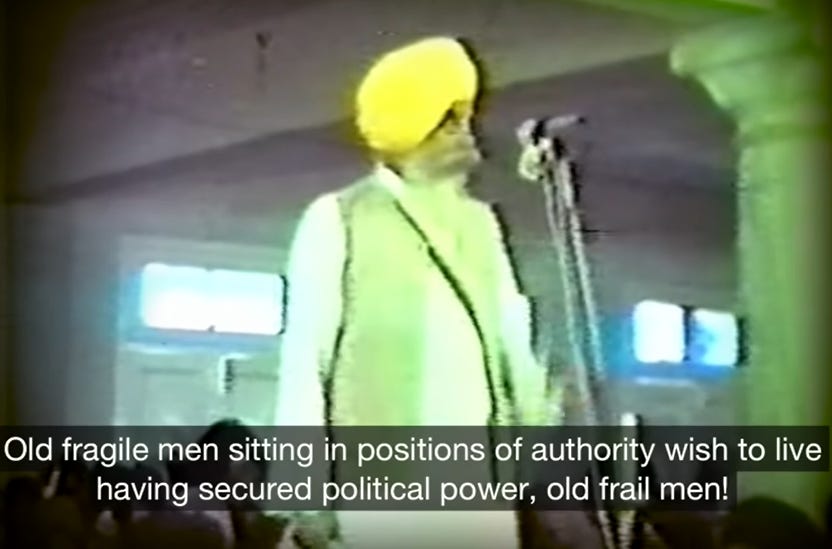
](https://substackcdn.com/image/fetch/f_auto,q_auto:good,fl_progressive:steep/https%3A%2F%2Fsubstack-post-media.s3.amazonaws.com%2Fpublic%2Fimages%2F7ac5ab74-2bb7-468f-8bc2-63dac1275fb7_832x549.png)
[
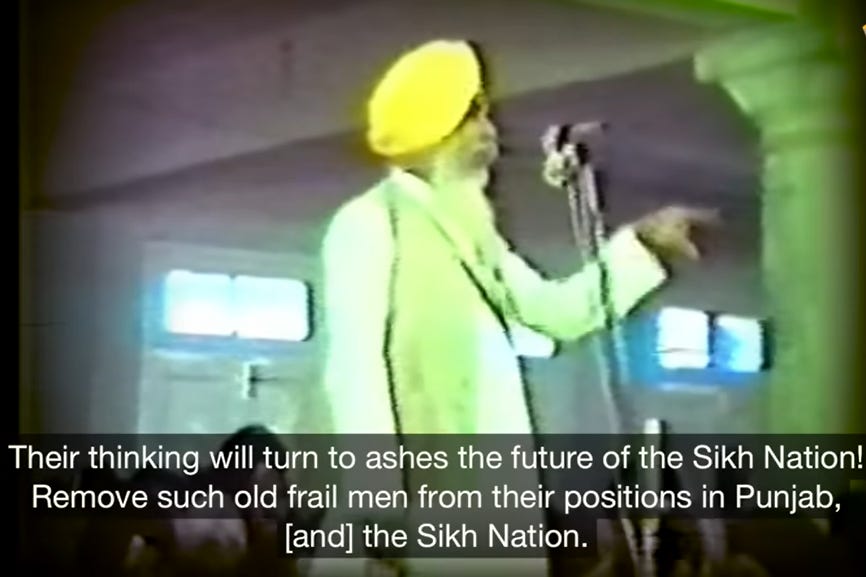
](https://substackcdn.com/image/fetch/f_auto,q_auto:good,fl_progressive:steep/https%3A%2F%2Fsubstack-post-media.s3.amazonaws.com%2Fpublic%2Fimages%2F81761e24-8c7d-4252-980d-4ebdb852cfe1_866x577.png)
It is interesting to pause for a moment and consider the modern depiction of a religious Khalsa Sikh. Often the image that comes to our mind is that of an elderly man with white beard and loving countenance. But for much of its precolonial history, the Khalsa was largely made up of men of fighting age—perhaps simply a consequence of attrition in the total war it waged against Mughals and Central Asian invaders, but true nonetheless.
Of course, the _counsel_ of elder Sikhs was much-valued, as the tales of Bhangu’s Panth Parkash attest to, but this was with the understanding that it came from battle-tested veterans. The power to _act_ lay in the consensus of the Khalsa vanguard to take the field, confirmed by incidents such as the infamous attack of several misls on the town of Kasur despite the warnings of elder Khalsas.[23](https://substack.com/home/post/p-150032752?utm_campaign=post&utm_medium=web#footnote-23-150032752) This is not the veneration of godmen, as some modern Sikh orders will interpret these incidents to be. The notion that modern day _sants_ and _babas_ could have exercised any degree of authority over the strategy of an organization like the Khalsa is, at best, unlikely. Here it is relevant to note that the Guru gave to the Khalsa _all_ of his powers, impliedly including the authority to upend tradition.
> ਜਾ ਵਿਧਿ ਅੰਮ੍ਰਿਤ ਤੁਮ ਗੁਰ ਪਾਯੋ । ਤੈਸੇ ਮੋਹਿ ਮਿਲਾਯੋ ਭਾਯੋ ॥
>
> Through this ceremony of _amrit_ (khande ki pahul) I have given you the Guruship, and in this way I have made you one with myself.[24](https://substack.com/home/post/p-150032752?utm_campaign=post&utm_medium=web#footnote-24-150032752)
Toward the end of the eighteenth century, another Sikh youngster will appear on the stage and upend Sikh practice. That is, of course, Ranjit Singh of the Sukerchakia Misl, who in the expansion of his power would discontinue the formal _gurmatta_ (lit. Guru’s order) gatherings—meetings of varying Sikh military powers in Punjab at Amritsar to confer and decide on group action against invaders. This move is much-criticized by those today who view the gurmatta as required by a sort of democratic corporatism inherent to the Khalsa’s nature.
[

](https://substackcdn.com/image/fetch/f_auto,q_auto:good,fl_progressive:steep/https%3A%2F%2Fsubstack-post-media.s3.amazonaws.com%2Fpublic%2Fimages%2Faac74b68-f539-419e-b4df-52da8789c10d_800x948.jpeg)
The Maharaja in his younger days, before his signature gray beard.
But Ranjit abandoning the gurmatta follows a pattern similar to Gurus Hargobind and Gobind Singh—the rejection of tradition in favor of functional improvements to the practice of Sikhism. By the time of the invasions of Nadir Shah’s grandson Zaman Shah into Punjab in the early 1790s, one observer noted of the misls that “there is the greatest enmity among them and continual war… the old chiefs, who were experienced in war and had fought against Ahmad Shah are all dead, and their children are untried.”[25](https://substack.com/home/post/p-150032752?utm_campaign=post&utm_medium=web#footnote-25-150032752) The teenage Ranjit Singh’s territory of Gujranwala was first in the path of Persian and Afghan invasions into Punjab, during which the general Sikh practice had been to engage the enemy in a hit-and-run strategy designed to inflict maximum damage while minimizing losses. But this meant nominally giving up territory, fighting as a tribe of anarchists and waiting for the invading force to eventually _leave_ before reestablishing power. For Ranjit, such a strategy had outlived its usefulness. The decision to centralize most Sikh territories under himself made the barely-adult Ranjit responsible for true Sikh sovereignty—not only the ability to fight invaders, but to keep them out of Sikh jurisdictions entirely.
### III. OVERCOMING THE SIKH YOUTH OF THE PAST
And so, less than a hundred years after a teenage Ranjit Singh transitions the Sikh confederacy to empire out of sheer force of will, less than two hundred years after Guru Gobind Singh condemned the masand tradition to historical irrelevance, and less than three hundred years after Guru Hargobind turned his back to practices purporting to be of Guru Nanak, in 1887 Professor Gurmukh Singh is expelled from the Panth for challenging men twice his age trying to preserve the glory days of a fallen kingdom.
Many may today accuse Gurmukh for not helping in the pursuit of “Sikh sovereignty.” After all, despite their flaws, weren’t Nihal Singh, Khem Singh Bedi, and the rest of the Sikh aristocracy trying to resurrect the Sikh Empire? The _Khurshid-i-Khalsa_ itself speaks favorably of the exiled Sikh prince, Maharaja Duleep Singh, as well as the “Kuka” rebellion launched by the Sikh sect now better known as the Namdharis. Couldn’t religious issues have been resolved _after_ attaining the ever-desirable _Khalsa Raj_?
But the same principle we’ve been discussing applies here. Painful as it is to say—there was no realistic shot of a Sikh rebellion succeeding in Punjab at the time. The Kuka Rebellion had been sadistically oppressed just the previous decade, and before that the failure of the 1857 Sepoy Mutiny ensured the British would pay special attention to any similar attempts for the foreseeable future. During the Anglo-Sikh Wars, Sikhs acted with the full power of their state resources, with clear access to troops, arms, and funds. To successfully rebel, Sikhs would have to count on the defection of Sikh soldiers from the British Indian Army, and even then the chances of success were likely very slim.
[

](https://substackcdn.com/image/fetch/f_auto,q_auto:good,fl_progressive:steep/https%3A%2F%2Fsubstack-post-media.s3.amazonaws.com%2Fpublic%2Fimages%2F4232a252-5594-4bb0-9fd2-d1d4397ca5c4_1200x865.jpeg)
The execution of Kukas by cannon in Malerkotla, Punjab, 1872.
What then should be the policy of the Panth? The young Gurmukh saw that instead of antagonizing their new rulers, instead it would be best to maintain cordiality with the British while the Khalsa rebuilds, both physically and philosophically. It’s not like such a move is totally without precedent in the Panth’s history—consider the move by Nawab Kapur Singh to accept a nominal _nawabi_ (feudal lordship) with the Mughals for its tax revenues, even after a period of all-out war with the Mughal state.[26](https://substack.com/home/post/p-150032752?utm_campaign=post&utm_medium=web#footnote-26-150032752)
Detente may well have been the best policy for the Panth in 1887. But the next generation of Sikh youth would _again_ see things differently. Though they accepted the religious framework of the Lahoris, from the start these new leaders cultivated an explicitly anticolonial stance. While a student at Khalsa College in Amritsar, in 1907 the future panthic stalwart Master Tara Singh would take part in his first of many protests against colonial power—lambasting the interference of the Punjab government in the affairs of the university.[27](https://substack.com/home/post/p-150032752?utm_campaign=post&utm_medium=web#footnote-27-150032752) His generation had imbibed Lahori beliefs, but they did not uncritically accept the idea that antagonism toward the British authority is necessarily bad. And perhaps for good reason—by 1907, Sikhs were no longer in the precarious position they found themselves in just twenty years prior. No one could question the necessity of the Sikh soldier to the British, not just in India but abroad as well, a fact that would soon be confirmed during World War I.
And so, now finding themselves budding leaders of the Panth, Tara’s generation would institute the Gurdwara Reform Movement in 1920, a five-year period of direct action across Punjab to implement the Lahoris’ beliefs. They leaned heavily on Sikh servicemen’s participation to force the British to acquiesce to the reformers’ demands.[28](https://substack.com/home/post/p-150032752?utm_campaign=post&utm_medium=web#footnote-28-150032752) So, just as Amritsaris now found themselves expelled from Panthic leadership, the Lahori philosophy was ironically implemented through the very anticolonial actions its founding generation disowned. The Sikh youth of Gurmukh’s generation had been overcome by Tara’s.
The Gurdwara Reform Movement was so successful in its radical reshaping of Sikh society that for a couple of generations, the resulting SGPC and its companion political party—the Shiromani Akali Dal (SAD)—faced no serious challenge from the Sikh youth. Probably because the Akalis sufficiently captured the youth’s inherent need for friction—the party was involved in the 1930s-40s tussles with the Muslim League of Punjab, and then after Partition stared down the Indian state and Congress party during the Punjabi Suba Movement of the 1960s and the Indian Emergency of the 1970s.
[
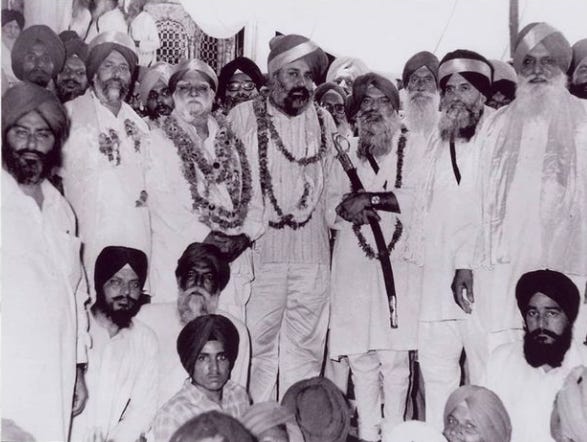
](https://substackcdn.com/image/fetch/f_auto,q_auto:good,fl_progressive:steep/https%3A%2F%2Fsubstack-post-media.s3.amazonaws.com%2Fpublic%2Fimages%2Fd16b3339-7a16-4cc0-b227-4c4ff000f1f3_587x442.png)
Prominent Akali leaders courting arrest during the Emergency.
But the Akalis of course, operate within the framework of electoral politics, the necessary result of an era of mass democracy. As the confrontation between Punjab and India’s central government progressed, a new youth leader emerged in the Panthic landscape. Clever despite his simple words and garb was Sant Jarnail Singh, head of the Damdami Taksal, previously obscure to most of Punjab prior to the launch of the Dharam Yudh Morcha in 1982. The morcha was began in conjunction with the Akalis, but the Sant, still just 35, clearly grew tired of the reliance on peaceful protest and jail-filling that had marked the party’s practice since the Gurdwara Reform Movement. The time was coming, in his view, to exit the realm of the voting booth and picket-signs and take politics to its most extreme theater—the battlefield.
Whether or not this was a correct assessment of what was necessary to protect Sikh interests at the time, the question for the Sant then was _how_ to convince the Sikh populace that such a step was necessary. The Akalis enjoyed great respect among religious Sikhs—the Akali president, Harchand Singh Longowal, was also genuinely seen as a “sant,” and the success of Punjabi Suba was fresh in everyone’s memory. The many sacrifices the party had given, drawn from the everyday folk of Punjab, made the term _Shaheedan da Jatha_ (“Band of Martyrs”) that the party was known by feel more real.
[
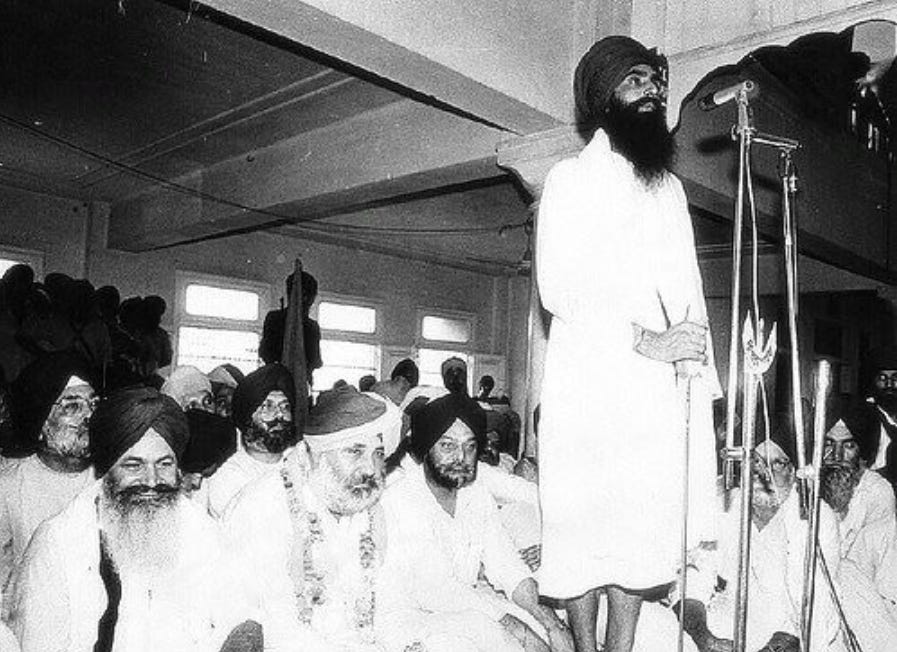
](https://substackcdn.com/image/fetch/f_auto,q_auto:good,fl_progressive:steep/https%3A%2F%2Fsubstack-post-media.s3.amazonaws.com%2Fpublic%2Fimages%2F160b5d8b-20d7-4210-bbb1-e1d6d972af6e_897x652.png)
Sant Jarnail Singh speaking from the infamous Manji Sahib stage. Seated to his left is Parkash Singh Badal and Harchand Singh Longowal.
And so, just as Professor Gurmukh Singh had to overcome the Amritsaris and Guru Gobind Singh had to overcome the masands, the Sant felt he had to overcome the Akalis. The Akali Dal—the result of the prior century’s Sikh youth—would in his view need to be supplanted by the Sikh youth of the 1980s. And so, the All India Sikh Student Federation—formerly loosely an Akali youth wing—was filled with young men who subscribed to the Sant’s vision. Bhai Amrik Singh, the son of the former head of the Taksal, Sant Kartar Singh, was already President of the AISSF. The 20-something Bhai Harminder Singh Sandhu, the personal assistant to the Sant, was made its General Secretary.
To drive his point home, the Sant even targeted Master Tara Singh in his speeches. For example, in defending Bhai Gajinder Singh’s 1981 hijacking of an airplane to protest the Sant’s arrest, he compares the disparate treatment meted out to Sikh and Hindu plane hijackers as follows:
> There is a restriction on us, but not the Hindus? Why is it so? It is because as yet we are slaves, and this slavery is due to our leaders having been greedy; it is because of Baldev Singh; and Master Tara Singh who was also the leader at that time with him (referring to Partition negotiations). The two of them were responsible for the destruction of the [Sikh] nation.
An objective analysis of the Sikh position during Partition shows its leaders did the best they could to preserve as much of Punjab in India as possible—the problem was the game of numbers, which Sikhs simply did not have despite their wealth and landholdings in now-Pakistan Punjab. Leaders like Tara himself also mobilized the Akal Fauj,[29](https://substack.com/home/post/p-150032752?utm_campaign=post&utm_medium=web#footnote-29-150032752) known colloquially as the ominous “jathas” that swept Punjab in response to massacres of Sikhs and Hindus during Partition.
[
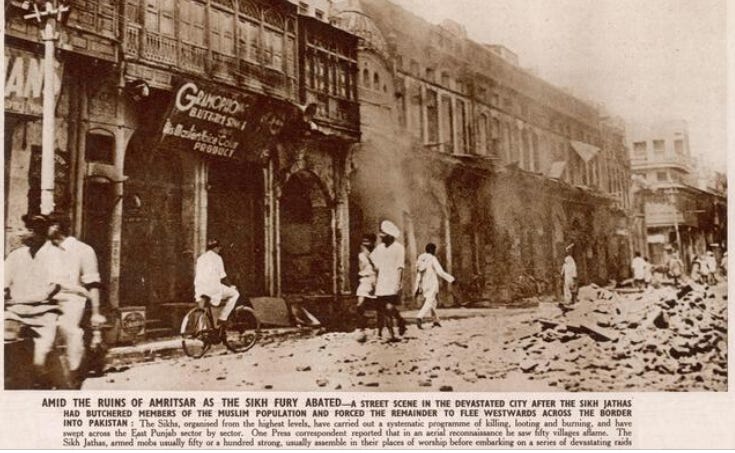
](https://substackcdn.com/image/fetch/f_auto,q_auto:good,fl_progressive:steep/https%3A%2F%2Fsubstack-post-media.s3.amazonaws.com%2Fpublic%2Fimages%2Fca1950a7-63e9-4aba-bd39-eacb82e931d1_735x453.png)
A newspaper clipping about the Sikh jathas
Yet despite being untrue, the Sant’s statements echo in a long line of Sikhs before him who sought to overcome the previous generation. The legend of Master Tara Singh added much to the Akali prestige—if the Sant found it in the best interest of the Panth to move past the Akali framework, perhaps he found it necessary to dull its luster.
The flanking of the Akalis from the Panthic angle was so successful that, following the Khalistan movement, the Akalis have little claim to their previous reputation of being Sikh hardliners. Such a position is essentially not represented in the current politics of Punjab, with few exceptions. To this day, the belief has become uncontroversial in some Panthic circles, particularly in the active diaspora, that Akali leaders during the 80s such as Longowal, Gurcharan Singh Tohra, and Parkash Singh Badal were actually traitors. Perhaps part of why we saw much of the Sikh youth coalesce around a new young figure, reminiscent of the Sant—Bhai Amritpal Singh.
[

](https://substackcdn.com/image/fetch/f_auto,q_auto:good,fl_progressive:steep/https%3A%2F%2Fsubstack-post-media.s3.amazonaws.com%2Fpublic%2Fimages%2F7bef5c0e-7af0-4266-93db-5d3cf4712e2b_648x375.jpeg)
Amritpal meets with Simranjit Singh Mann, leader of SAD (Amritsar), against a backdrop of pictures of Sant Jarnail Singh
But there is an issue. Amritpal and the current generation of Sikh _naujawan_ have not yet fulfilled their duty: the duty to overcome the previous generation of Sikh youth. This role is not simply fulfilled by targeting the _nominally_ Sikh institutions such as the Akalis and the SGPC. Complaints about these institutions are in vogue across the Sikh sphere—calling for their dissolution can almost be considered mainstream.
Rather, the duty of this generation will be to overcome the beloved _kharkus_, symbolized by Sant Jarnail Singh. It is they who occupy the roost of the sacred in the Sikh consciousness, just as Guru Nanak did at the time of Guru Hargobind, just as Khem Singh Bedi did at the time of Professor Gurmukh Singh, and just as Master Tara Singh did at the time of the Sant himself. It is only through such “overcomings” that genuine change has been built—the first leading to Sikh militarization, the second leading to the Lahore Singh Sabha, and the latter leading to the epic Khalistan movement.
This does not mean we do not honor their sacrifices, and it does not mean we cast aside all the beliefs they held dear. But it does mean that we learn how to see the kharkus as human. How to recognize their mistakes and their flaws, and realize that _just because_ a kharku practiced Sikhism a certain way _does not mean_ we must as well.
Of course, this applies to _any_ Sikh of the past, whether he be Nihang, Nanaksar, or of the Lahore Singh Sabha. But I think it undeniable that the Sant and the kharkus hold a special place in the hearts of many today. These are Sikhs who, within living memory, laid their lives on the line to uphold the independence of Sikh tradition and bring justice to those who wronged the community. Pretending this isn’t admirable is heartless.
Yet this is exactly why such a generation _must_ be “overcome.” Many of the beliefs and traditions instituted by those who fought for Khalistan have outlived their use, and now hold the Panth back from acheiving this goal. (At the very least, reasonable minds could disagree on them.) Yet the sacrifices of this generation become a cudgel against which dissent is smashed—”_they_ died for [insert practice here]” goes the argument. And because the very mention of their names—Sant Jarnail Singh, Baba Gurbachan Singh Manochahal, Bhai Sukhdev Singh Babbar, etc., carries the weight of their sacrifice upon invocation, the rhetorical device, although obviously fallacious, is quite effective. We are, after all, an emotional people.
But to truly honor their sacrifices—to ensure that it was not for nothing—the kharkus will need to be “overcome.” In a way, every single generation of Sikh youth who broke with their ancestors had the same vision: the protection of Sikh interests and the practice of Sikh sovereignty. Guru Nanak, Guru Hargobind, Guru Gobind Singh, Maharaja Ranjit Singh, Professor Gurmukh Singh, Master Tara Singh, and Sant Jarnail Singh are at their core aligned ideologically. Yet each, in their youth, broke away from prevailing norms. This break—this _overcoming_—was to ensure the _vision_ of Sikhism stays alive to meet the exigencies of a new world.
The Sikh youth of today find ourselves in a situation akin to Gurmukh Singh in 1887— dealing with the machinations of old men aspiring for Sikh Raj using the tactics of yesteryear. Just like the men who survived the Anglo-Sikh Wars, the men who survived the Khalistan movement look to the present Sikh youth to continue the dream they couldn’t fulfill. Like Gurmukh, we may empathize with these men. We may too aspire for a Sikh state. Yet we see, as Gurmukh did, that what is holding us back is not just the appetite for a fight—it is our philosophy itself, our ideological groundings. The men who survived the Khalistan movement, just like the men who survived the Anglo-Sikh Wars, do not realize how much the world has changed, and will continue to change. They cannot predict what is to come—well, no one can. But the future is something the young are closer to simply as a matter of chronology. To truly respect the sacrifices of the martyrs for Khalistan, who gave their lives for the vision of Guru Nanak, it will require reexamining what exactly that vision is, and its fearless implementation no matter what the beliefs of Sant Jarnail Singh or anyone before him. It is the Sikh youth’s duty to overcome the sacred, just as Guru Nanak did.
[

](https://substackcdn.com/image/fetch/f_auto,q_auto:good,fl_progressive:steep/https%3A%2F%2Fsubstack-post-media.s3.amazonaws.com%2Fpublic%2Fimages%2Fbce11d47-f663-40af-8602-fbccfb50aab9_804x783.png)
Young Sikhs, fighting for Khalistan, pause and take a dip in the Darbar Sahib sarovar.
[1](https://substack.com/home/post/p-150032752?utm_campaign=post&utm_medium=web#footnote-anchor-1-150032752)
Gurdev Singh Sidhu, _Professor Gurmukh Singh: Jivan Te Rachna_ p. 11 (1989).
[2](https://substack.com/home/post/p-150032752?utm_campaign=post&utm_medium=web#footnote-anchor-2-150032752)
_Id._ at 10.
[3](https://substack.com/home/post/p-150032752?utm_campaign=post&utm_medium=web#footnote-anchor-3-150032752)
_PGSJ_ at 5.
[4](https://substack.com/home/post/p-150032752?utm_campaign=post&utm_medium=web#footnote-anchor-4-150032752)
_Id._
[5](https://substack.com/home/post/p-150032752?utm_campaign=post&utm_medium=web#footnote-anchor-5-150032752)
_Id._ at 6.
[6](https://substack.com/home/post/p-150032752?utm_campaign=post&utm_medium=web#footnote-anchor-6-150032752)
_Id._
[7](https://substack.com/home/post/p-150032752?utm_campaign=post&utm_medium=web#footnote-anchor-7-150032752)
_Id._ at 7.
[8](https://substack.com/home/post/p-150032752?utm_campaign=post&utm_medium=web#footnote-anchor-8-150032752)
_See id._ at 6-9.
[9](https://substack.com/home/post/p-150032752?utm_campaign=post&utm_medium=web#footnote-anchor-9-150032752)
_Id._ at 7.
[10](https://substack.com/home/post/p-150032752?utm_campaign=post&utm_medium=web#footnote-anchor-10-150032752)
_Id._ at 8.
[11](https://substack.com/home/post/p-150032752?utm_campaign=post&utm_medium=web#footnote-anchor-11-150032752)
_Id._ at 10.
[12](https://substack.com/home/post/p-150032752?utm_campaign=post&utm_medium=web#footnote-anchor-12-150032752)
Rajbir S. Judge. _Reform in Fragments_, at 1143.
[13](https://substack.com/home/post/p-150032752?utm_campaign=post&utm_medium=web#footnote-anchor-13-150032752)
_Id._ (Gurmukh Singh claims reviewers had asserted they had only read some of the book published, not all of it).
[14](https://substack.com/home/post/p-150032752?utm_campaign=post&utm_medium=web#footnote-anchor-14-150032752)
_Id._ at 1140.
[15](https://substack.com/home/post/p-150032752?utm_campaign=post&utm_medium=web#footnote-anchor-15-150032752)
_Id._ (citing India Office Records).
[16](https://substack.com/home/post/p-150032752?utm_campaign=post&utm_medium=web#footnote-anchor-16-150032752)
J.S. Grewal, _The Sikhs of the Punjab_ p. 158 (2nd ed., 2008).
[17](https://substack.com/home/post/p-150032752?utm_campaign=post&utm_medium=web#footnote-anchor-17-150032752)
Mohinder Singh, _The Akali Movement_ p. 23-24 (1997 ed.).
[18](https://substack.com/home/post/p-150032752?utm_campaign=post&utm_medium=web#footnote-anchor-18-150032752)
Guru Nanak, Ang 470, Raag Asa.
[19](https://substack.com/home/post/p-150032752?utm_campaign=post&utm_medium=web#footnote-anchor-19-150032752)
Bhagat Singh, _Gurbilas Patshahi—6 (Punjabi)_ p. 249-50 (ed. Dr. Gurmukh Singh, 1997) (18th cent.).
[20](https://substack.com/home/post/p-150032752?utm_campaign=post&utm_medium=web#footnote-anchor-20-150032752)
Kavi Sainapati, _Sri Gursobha_ p. 59-60 (Kulwant Singh transl., 2014) (dated to 1711).
[21](https://substack.com/home/post/p-150032752?utm_campaign=post&utm_medium=web#footnote-anchor-21-150032752)
Koer Singh, _Gurbilas Patshahi 10_ p. 60 (Shamsher Singh Ashok ed., 1972).
[22](https://substack.com/home/post/p-150032752?utm_campaign=post&utm_medium=web#footnote-anchor-22-150032752)
_Id._ at 62.
[23](https://substack.com/home/post/p-150032752?utm_campaign=post&utm_medium=web#footnote-anchor-23-150032752)
Ratan Singh Bhangu, _Sri Gur Panth Parkash Volume II_ p. 557 (Kulwant Singh trans., 2010).
[24](https://substack.com/home/post/p-150032752?utm_campaign=post&utm_medium=web#footnote-anchor-24-150032752)
Koer Singh, _Gurbilas Patshahi 10_ p. 112 (Shamsher Singh Ashok ed., 1972).
[25](https://substack.com/home/post/p-150032752?utm_campaign=post&utm_medium=web#footnote-anchor-25-150032752)
Letters of Sir Charles Malet (1794).
[26](https://substack.com/home/post/p-150032752?utm_campaign=post&utm_medium=web#footnote-anchor-26-150032752)
_See_ Episode 90: The Episode About the Title of Nawabship on S. Kapoor Singh _in_ Panth Parkash Vol. II, _supra_ note 22.
[27](https://substack.com/home/post/p-150032752?utm_campaign=post&utm_medium=web#footnote-anchor-27-150032752)
_See_ Early Life and Career of Master Tara Singh _in_ J.S. Grewal, Master Tara Singh in Indian History: Colonialism, Nationalism, and the Politics of Sikh Identity (2018).
[28](https://substack.com/home/post/p-150032752?utm_campaign=post&utm_medium=web#footnote-anchor-28-150032752)
_See_ Mohinder Singh, _supra_ note 18, at p. 44.
[29](https://substack.com/home/post/p-150032752?utm_campaign=post&utm_medium=web#footnote-anchor-29-150032752)
[
## The Akal Fauj
](https://khalsachronicle.substack.com/p/the-akal-fauj)
[Rattan Singh (SirPentapotamia)](https://substack.com/profile/49475367-rattan-singh-sirpentapotamia)
·
23 August 2022
[](https://khalsachronicle.substack.com/p/the-akal-fauj)
[
In February 1947, Sikh leaders began to discuss the creation of a private Sikh militia to prepare against Muslim League onslaught, as a reaction to previous massacres such as the Rape of Rawalpindi. As a result, Master Tara Singh stated his aim was:
](https://khalsachronicle.substack.com/p/the-akal-fauj)